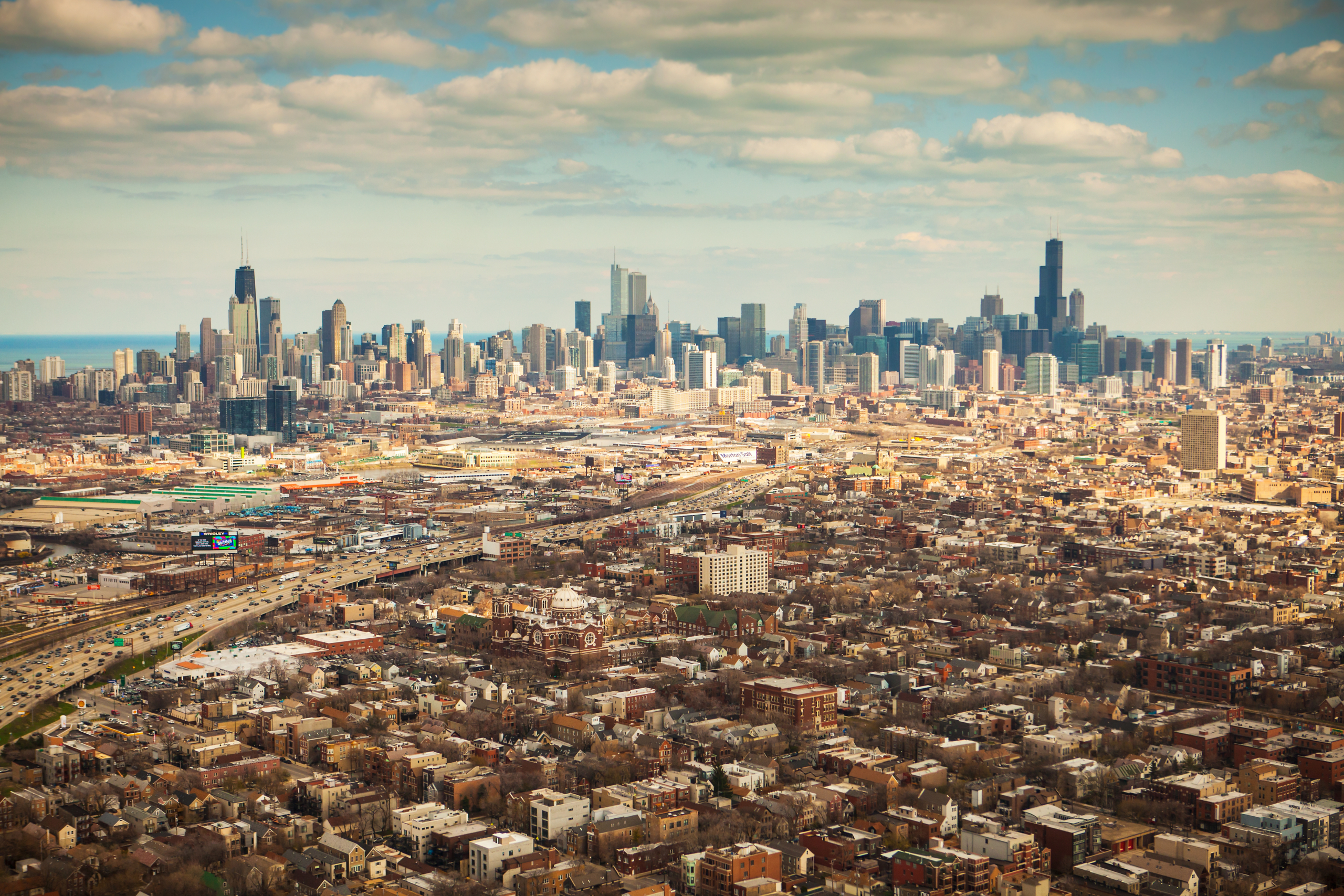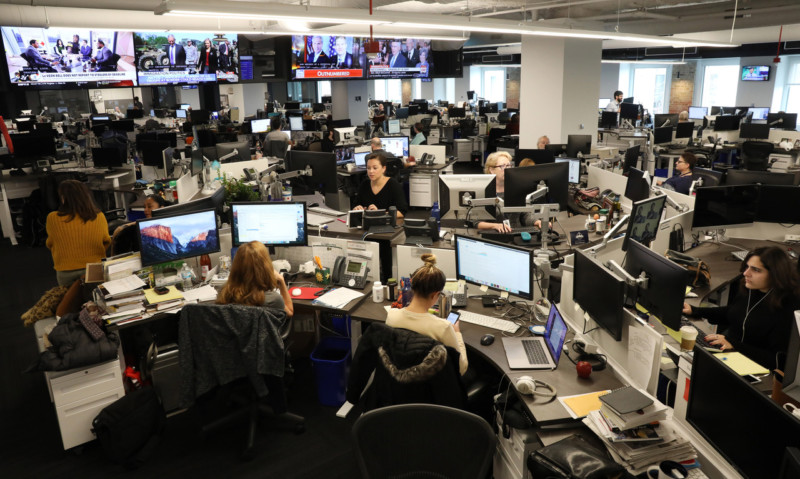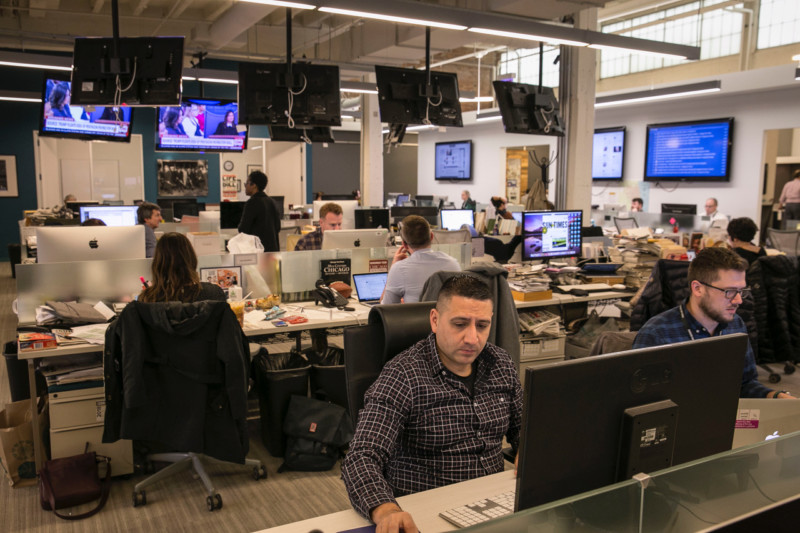Sign up for the daily CJR newsletter.
In June 2018, when the Chicago Tribune packed up and left its famous Tribune Tower newsroom, it seemed like an obvious symbol of local journalism’s decline. Gone were the days when Chicago’s biggest paper held a commanding position on the banks of the Chicago River. The move followed two rounds of layoffs, in which the newsroom lost more than two dozen staffers. The first time, Bruce Dold, the editor in chief and publisher, had blamed “significant financial pressure.” Later, Marisa Kollias, vice president of communications, released a statement saying that “The Chicago Tribune is reshaping its newsroom and making important steps in our ongoing effort to become more a digital enterprise.”
Recently, I met Dold at the paper’s shiny new office across the street from downtown’s Millennium Park. For all the nostalgic value of the old building, he argued, the new space—which features an open office plan and glass-walled conference rooms clustered around a grand set of dark wood steps—is a better fit for the Tribune’s attempts to ride out the waves of the digital era. “Having a breaking-news desk next to the audience team next to sports next to business, it’s easier communication than there was in the old place, with a lot of nooks and crannies in the newsroom,” he said. Dold is confident in the Tribune’s position at the center of local media in Chicago. The Tribune has surpassed 110,000 digital subscribers, he said, placing it second only to the Los Angeles Times among regional papers. He cites the Tribune’s robust audience research tactics, dedicated statehouse coverage even as many other papers have cut back, and a ramped-up social-media strategy as examples of the Tribune’s continued success.
Dold’s optimism is consistent with a trend journalists and readers are seeing across Chicago: while some of the city’s diverse local news publications are struggling, others are growing, and some are even thriving. After a difficult 2017 and 2018—during which the city seemed at risk of losing one of its independent dailies, its famous alt-weekly, and a daily neighborhood news source—the state of the media in Chicago looks less like another sad journalism story and more like an example of what can happen when things appear to be working.
ICYMI: News knowledge as inoculation
In a city with a long history of public corruption and systemic racism, the stakes are high. Residents of marginalized communities often don’t see themselves reflected in mainstream news coverage, and it can be hard for advertising-dependent ethnic or neighborhood-based outlets to survive. But new organizations are rising in response to this need, determined to counter longtime media blind spots and better cover the city as a whole.
“Chicago right now is one of the most entrepreneurial and experimental local news markets in the country,” says Tim Franklin, a senior associate dean at Northwestern University’s Medill School of Journalism and director of the Medill Local News Initiative. “I’m energized by it and excited by it. Chicago is this stew that has a lot of different journalism ingredients in it. And you’re beginning to see some of this experimentation start to bubble up.”
As a local media market, Chicago has several factors going for it. It’s a huge city with a big well of local talent and a large philanthropic presence. Few national outlets are based here, and so most local resources go directly into local reporting. It has a long history of political misconduct and vibrant grassroots activism, which means its citizens are especially engaged and its reporters prioritize accountability journalism. And, in recent years, upstart and legacy outlets alike have wholeheartedly embraced collaboration, finding creative ways to ensure that necessary stories are told.
Just one neighborhood west of the Tribune, the Sun-Times, Chicago’s other daily paper, is also settling into new office space, under the leadership of an investment group led by the Chicago Federation of Labor that stepped in to buy the paper in July 2017 to save it from acquisition by Tribune Publishing. “I joke around that, you know, maybe the newsroom would have ended up in a broom closet at the Freedom Center,” Chris Fusco, the editor in chief, says, referring to the out-of-the-way plant building where the Tribune’s papers are printed. “The bottom line is, it was a new day for us.” Now the paper is housed in the West Loop, in a space shared with a multimedia production company. Reporters work from an open-plan office in the start-up style, complete with exposed-brick stairwells.
On a tour, Fusco showed off an all-white TV studio, where Stephanie Mansour, a fitness coach, was recording an exercise video, and an audio booth where Ben Joravsky, a senior writer for the Chicago Reader, was streaming a podcast he produces in collaboration with the Sun-Times. These multimedia projects are part of a balancing act, Fusco said, to remain up to date without compromising the commitment to text-based news; they’ve also rolled out new coverage (on everything from sports to murals) and a sleek new website. “I think the key to survival for a regional newspaper in 2019 is you have to do a little bit of everything,” Fusco said. “But remember what your legacy product is. It’s kind of cool to see that diversification of what we’re doing. But you can’t rely too heavily on one thing, because that’s a recipe for death.”
WBEZ, Chicago’s local NPR affiliate, is also growing its traditional operation while trying new things. “Public radio has the model to support local journalism in a way that no other commercial entity does,” Goli Sheikholeslami, who until recently served as CEO, says, referring to the station’s multistream revenue model, which combines advertising, memberships, and institutional giving. WBEZ launched an app in 2015 and has continued to invest in digital expansion. In the past few years, it has aggressively pursued local talent, including reporters without radio backgrounds, such as Dan Mihalopoulos, one of the city’s most respected political investigative reporters. And while most of Chicago’s daily digital news sources (which include the Tribune, Sun-Times, and Block Club Chicago) are paywalled, WBEZ, like all NPR stations, remains free. “We are moving into a world where access to news and information is only accessible to those who have the means to pay for it,” Sheikholeslami says. “And we think that is why it’s so important for public media to continue to be a source of free information and news that people need to make decisions about their own lives and their families.”
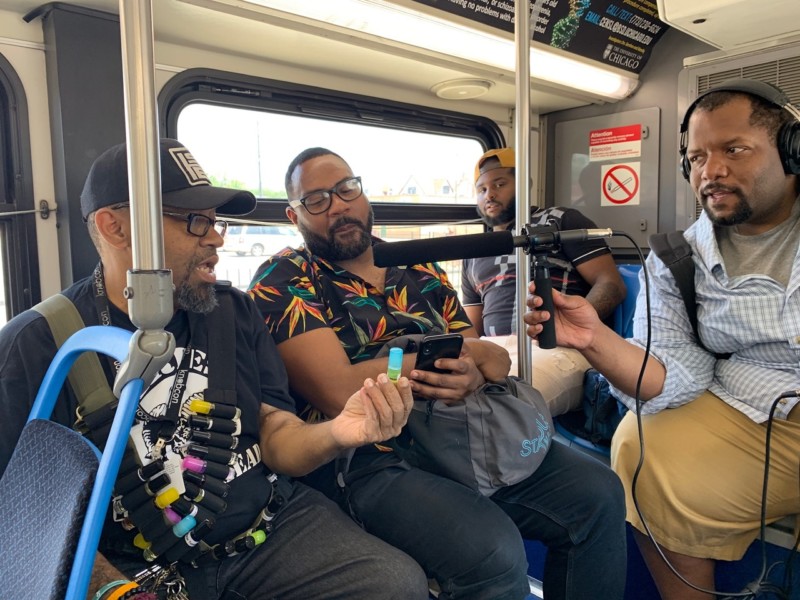
WBEZ Producer James Edwards (right) interviews (from left) Dave Helem and James “The Oil Man” Redmond for the South Side Stories podcast. Bia Medious/WBEZ.
NONPROFIT MEDIA, a model on the rise around the country, is not a new force in Chicago. The Better Government Association (BGA), a donor-supported watchdog organization that often partners with other outlets, has produced in-depth investigative reporting since the fifties. The Chicago Reporter, now an online-only magazine housed and funded by the nonprofit Community Renewal Society, has covered race and poverty since 1972.
Recently, a crop of new organizations has joined these older players. In 2018, after Joe Ricketts, the owner of DNAinfo Chicago, abruptly pulled the plug, former editors founded a nonprofit site called Block Club Chicago, which they launched with support from foundations and a Kickstarter campaign that raised more than $183,000, breaking Kickstarter’s local-journalism fundraising record. Block Club, which runs on Civil’s platform and uses a digital subscriber model, now has nine reporters covering neighborhoods across the city.
Perhaps the most prominent new nonprofit is ProPublica Illinois, which launched in the fall of 2017 as the national investigative outlet’s first regional operation. All of ProPublica Illinois’s reporters and editors, including Louise Kiernan, the editor in chief, were hired from within the existing Chicago media scene, most of them from the Tribune. Set up with a staff of twelve, ProPublica Illinois has already found success with projects like its 2018 “Driven into Debt” series, which, in partnership with WBEZ, exposed how Chicago’s vehicle ticketing system has sent thousands of low-income Black residents into bankruptcy, and how debt-collection practices for unpaid tickets disproportionately affect Black and low-income neighborhoods. As a result of the reporting, the city clerk convened a task force to study the problem, and Mayor Lori Lightfoot announced last month that she would support a state law to stop suspending driver’s licenses for unpaid tickets and proposed a variety of measures to lessen the burden of ticket debt on Chicago families.
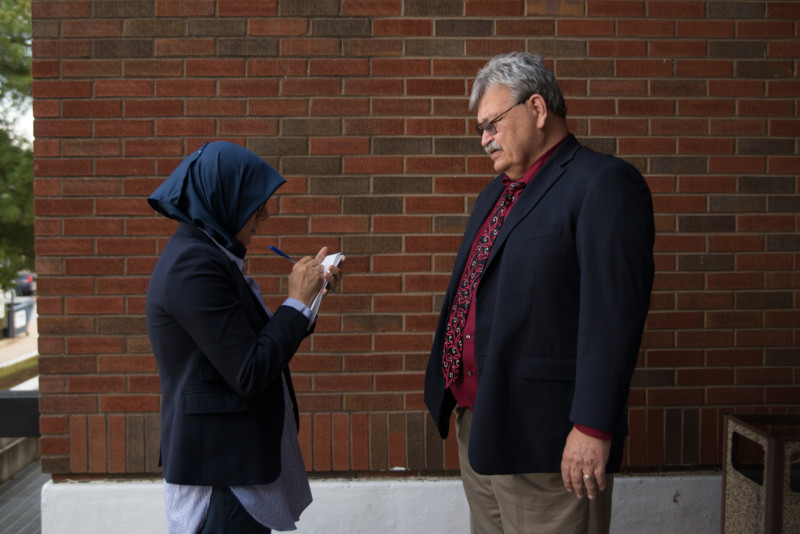
ProPublica Illinois reporter Duaa Eldeib, left, interviews a public defender in Harrisburg, Illinois, for a story about lengthy adult prison sentences being given to young men at a local juvenile facility. The Illinois governor later commuted the sentences of a half-dozen men whose cases were documented in her story. Nick Schnelle for ProPublica Illinois.
City Bureau, a nonprofit “civic journalism lab” founded on the South Side in 2015, connects journalists and community members. Its Documenters program trains citizens to report on public agency meetings—which it pays them by the hour to cover. The Documenters website scrapes city and county meeting agendas and minutes from across the Web, centralizing them on one platform. (Disclosure: I’ve worked with City Bureau in various capacities over the past few years, including as a reporting fellow, an intern, and a contractor.)
Over a thousand Documenters are enrolled. “We’re probably reading through more local government records than most publications,” says Darryl Holliday, a City Bureau cofounder and its news lab director. At times, Holliday says, information obtained by Documenters is shared with local reporters; on some occasions, City Bureau journalists produce stories and newsletters based on this content, crediting Documenters for their reporting. City Bureau also plans to begin sharing some tips from Documenters with local reporters.
City Bureau encourages Documenters not only to transcribe notes but also to provide personal insights into the proceeding. “We had a Documenter who had been at the first Local School Council meetings two decades ago, and she wanted to cover Chicago Public Schools because she had the invaluable experience that a lot of reporters don’t even have,” Holliday says. “We encouraged her to make those connections—‘Do you remember? Was it the same?’ We don’t want Documenters to be making minutes. We aren’t just having them be stenographers.”
MANY NEW JOURNALISM OUTLETS are interested in covering the city in ways that mainstream legacy media have never done. In a city that’s one of the nation’s most segregated, many members of Black and Latinx communities, especially on the South and West Sides, feel like mainstream media have never comprehensively covered their communities, or that existing coverage is disproportionately focused on crime, perpetuating racist stereotypes.
In 2018, City Bureau partnered with the University of Texas at Austin’s Center for Media Engagement to commission a study of how nine hundred Chicago residents viewed local news coverage of their neighborhoods. The study found that South and West Side residents were more likely than residents of the North Side and downtown to see coverage of their neighborhoods as “too negative” and to believe it “quotes the wrong people.”
“I digitally subscribed to the Chicago Tribune for a month, and every single time I clicked on the link, the first page was a negative story of somebody Black,” says Angela Ford, founder of the Obsidian Collection, an organization that preserves, digitizes, and shares images from historical African-American newspapers. “Every time I clicked on it. It was untenable, how aggressively racist I found the Chicago Tribune. I just couldn’t believe it. So I stopped subscribing, because I’m not going to accept that definition of my community.”
In the past, in-depth coverage of the Black community was provided by independent Black media such as the Chicago Defender, one of six Black papers in Chicago. But familiar industry trends have affected Black media: a report published in February by Ford and other Obsidian Collection staff found that, in communities across the country, Black legacy publications have shuttered or are struggling to survive. In July, after years of diminishing circulation, the Defender announced it was ending its print edition and focusing on digital only. “I have a millennial son,” Ford says. “And he doesn’t read newspapers. That’s not how he obtains information. So I see there’s a reality that things are different. On the other hand, I have elders, mentors, that still read print. Seeing their news source cut off that abruptly was hard.”
Ford is confident that, as it always has, the Black community in Chicago will find ways to tell its stories. One new media organization she’s particularly excited about is the Triibe, a digital media company founded in 2017 by Tiffany Walden, a journalist, and Morgan Elise Johnson, a filmmaker. The Triibe started out targeting Black millennials, but has since expanded its audience to all of Black Chicago. The Triibe reports on news relevant to Black Chicago—for instance, it was the first outlet to cover the city’s demolition of the headquarters of Assata’s Daughters, a racial-justice group—and offers a variety of culture stories. The Triibe also provides a forum for Black Chicagoans to write op-eds. “A huge component of the Triibe is media education,” Johnson says, “showing Black people why it’s important to have ownership of the stories that we tell, and to try to get us a platform to tell those stories.” Last Monday, Johnson announced on Twitter that the Triibe had received its first grant, from the Field Foundation, which she called a “game changer” for the outlet.
NOT EVERY OUTLET in Chicago radiates optimism. The Austin Weekly News, which was founded in 1986 by the suburban publisher Wednesday Journal, covers communities on the West Side. For years, the paper’s coverage has been enriched by being hyperlocal: in 2015, for example, the father of a 19-year-old named Quintonio LeGrier called the police to ask for help calming down his son, who struggled with mental illness and had started swinging a bat; the Chicago police officer who arrived shot and killed LeGrier and a neighbor, fifty-five-year-old Bettie Jones. The media covered the incident widely, and many local outlets showed up to Jones’s funeral, but the Austin Weekly News was the only outlet to cite the parts of Rev. Michael Hatch’s eulogy comparing the Chicago Police Department’s presence on the West Side to an occupying force in a foreign country. “We covered those comments to make sure that we’re telling the stories from a systematic viewpoint, that we’re not leaving out those systems and structural forces that really form the backdrop of everyday occurrences,” says Michael Romain, the paper’s editor.
But keeping a hyperlocal independent publication afloat to tell those stories is difficult. Romain is the Austin Weekly News’s only editorial employee, and he spends much of his time as a reporter for other Wednesday Journal–owned publications in nearby suburban neighborhoods. He relies on a handful of freelancers to help him cover the West Side. Romain’s hours are long and the pay is low. The Wednesday Journal is in the process of converting into a nonprofit, and Romain hopes to make part of its mission training journalists of color from the West Side.
The South Side Weekly, founded in 2013 by University of Chicago students, is another hyperlocal weekly seeking a sustainable revenue model. An alt-weekly providing in-depth coverage of South Side arts, culture, and politics, it became independent of the university in 2014 and is now staffed by a large team of volunteer reporters, editors, and artists. It is currently looking to secure more grant funding in order to pay contributors, while continuing its mission of offering writers of varying experience levels opportunities to contribute and learn journalism skills. On September 11, the Weekly received its first general operating grant, for $50,000, from the McCormick Foundation. (Disclosure: I’m paid to manage the Weekly’s free journalism workshop series.)
While it puts all content online, the South Side Weekly is committed to publishing in print; copies are distributed in newsboxes across the South Side for free. “I think a lot of people will talk about print solely as a business model, and the decline of that print being a loss for the business model, but very few people will talk about it as an accessibility issue,” Jason Schumer, the Weekly’s operations director, says. “And I think the reality is that there’s still a lot of people in this country that rely on print to get news.”
And then there’s the Chicago Reader, whose circulation model and literary journalism once influenced alt-weeklies around the country. It’s narrowly avoided closure several times. In 2018 it was sold to a new group of investors, STM Reader LLC, led by Dorothy Leavell, the publisher of the Chicago Crusader, in a deal that relied on Tracy Baim, the longtime publisher and owner of the Windy City Times, a local LGBTQ outlet. In a hasty arrangement enabled by the Reader’s union, Baim put together a budget for keeping the paper afloat, and then came aboard to run it.
A year later, Baim says, the Reader is still losing money, but revenues are increasing, and she hopes to be able to close the gap via partnerships with other outlets and support from foundations. To Baim, the decline in local print news—as smaller outlets end print circulation or move to publishing less often—makes for less competition, and she sees that as a potential boon for the Reader. “Maybe people are valuing print because there aren’t as many opportunities to get print for free,” she says. “For our advertisers, what we’re trying to do with them is to say, ‘Hey, you need to be in print, you need to be in digital, and we’ll give you a great deal to be in both.’” Since Baim came on a year ago, circulation has increased to about fifty-five thousand papers a week, up from fifty thousand.
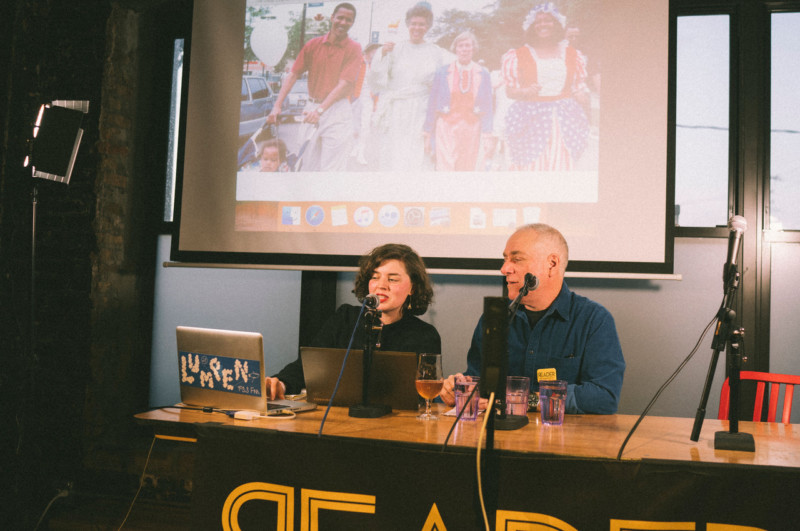
Reader reporters Maya Dukmasova (left) and Ben Joravsky at the Reader’s March election-night event at Mars Brewing Company. Photo by Alexa Viscius.
It’s unlikely that the Reader will ever return to churning out two hundred print pages weekly, as it did in its heyday. But under new ownership and new co–editors in chief Sujay Kumar and Karen Hawkins, the paper is less anemic than it has been in recent years. In May the Reader published a thorough investigation into a property management company responsible for thousands of evictions. A July issue celebrating Pride Month featured stories on the experiences of LGBTQ asylum seekers in immigration court and on an event planning company that hosts parties for Black and queer audiences—true to the Reader’s history of offering in-depth reporting and covering the city’s subcultures.
Baim, Hawkins, and Kumar are trying to preserve the Reader’s legacy while expanding its audience to more Chicagoans. The Reader has long been associated with a white North Side audience and a mostly white staff. (Last year, the paper fired executive editor Mark Konkol after two weeks when he printed a racist political cartoon on the cover.) Now the Reader—“fifty percent African-American owned,” its site notes, and overseen by two editors who are people of color—hopes to change its image and better connect with Chicagoans of color. The paper has expanded distribution routes and hosted events on the South Side, where its new offices are located, in Bronzeville; bylines have become more diverse.
Still, Baim admits, pulling an alt-weekly out of a hole is difficult. She’s trying new ideas, like the Reader Media Group, an advertising partnership she formed with other community papers and ethnic media outlets across the city, including the South Side Weekly, La Raza, and the Korea Times. Advertisers can buy a package to appear in the whole group of papers at once. Baim is also leading an effort to reach out to all of Chicago’s media entities that aren’t corporate owned, which number more than a hundred and thirty, to see if any are interested in joining together to work on projects that would help everyone survive. Her dream, she says, is to put together a group of local outlets that will unite for an annual fundraiser for all independent media, and to find a partnering foundation to match their proceeds. “I know that we are trying everything, every spaghetti noodle’s hitting the wall,” she says. Will it work? “I’m not sure.”
There have been other attempts at collaboration in pursuit of collective survival and increasing public access to news: the Sun-Times, for example, publishes content from the BGA, ProPublica Illinois, and an investigative nonprofit called Injustice Watch. The Triibe publishes a regular feature in the Chicago Reader called Block Beat, in which Triibe writers interview Chicago musicians. Even the Tribune, usually a solo flier, worked with WBEZ last year to publish the acclaimed Sixteen Shots podcast, covering the trial of Jason Van Dyke, the police officer who fatally shot Laquan McDonald, an unarmed teenager. Online-only publications including the Chicago Reporter, the BGA, and Belt Magazine partner with the South Side Weekly to run stories in print and reach a wider audience on the South Side. In one gigantic collaboration, ten outlets came together to centralize information about this year’s local elections on a website called chi.vote.
That willingness to collaborate—to work across traditional boundaries between journalism and to occasionally abandon competition in the face of local journalism’s uncertain future—feels increasingly characteristic of Chicago journalism. “I just love that everybody here is connected in some way,” Bettina Chang, a founder of City Bureau, says. “It’s a big city, but sometimes it feels like a small town in that people know each other and they vouch for each other.”
RECENTLY: The impeachment story and the proportionality problem
Has America ever needed a media defender more than now? Help us by joining CJR today.



